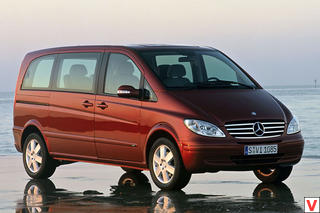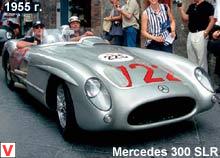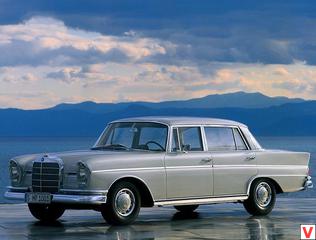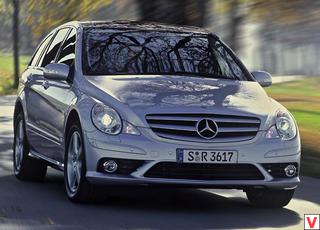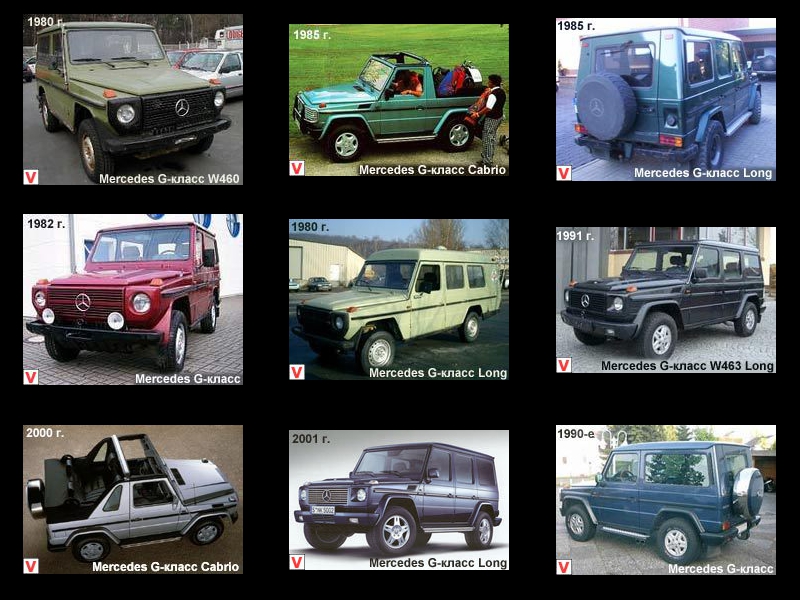
Mercedes-Benz G – class is a series of all-terrain vehicles. Gradually aging veteran Gelandewagen ("Gelendvagen") (Mercedes G-Class) has been produced since 1979, but is not going to retire. Its production will be curtailed not earlier than 2005.
The small demand for these rather expensive cars, which are distinguished by enviable durability and maneuverability, entail a relative constancy of design and a minimum of changes made. Over the past 2-3 years, the G-class models (chassis code W463 and W461 only for the 290GD TD model) have changed slightly. The decision to develop an SUV was made in 1972. The first wooden model was ready in April 1973, and a year later a metal prototype appeared.

Uncomplicated rectangular shapes, hollowed out on wooden models, turned out to be so versatile that they reached to the present day without significant changes: a spar frame, continuous front and rear axles, all-wheel drive transmission with a multiplicator, a folding soft top, removable sidewalls of doors, a front glass sliding onto the hood, spartan interior. The first serial car series 460 went to the Federal Border Service of Germany in February 1979. Soon after, orders from other countries of Europe and Asia were received for this “off-road vehicle” - and this is how it can be transferred from the German Gelandewagen. Small-scale production allowed to carry out special orders.
For example, generals from Indonesia ordered cars without doors, but with huge scissors on the front bumper - for cutting barbed wire. Cars for foresters, fire protection, ambulances were built. I saw the light and the unique "Papamobil" - an armored car for the Pope. Modifications were made of 230G, 240GD, 280G and 300GD series 460. In 1980, there were modifications with a hard top, as well as with short and long bases. A year later, the Gelandewagen design was updated, offering a protective grille on the front headlights, removable hard-top, automatic transmission, air conditioning and somewhat different equipment.

In 1982, the 2.3-liter gasoline engines carburetors gave way to fuel injection. And the next year, the company's engineers carried out a second modernization of the car, first introducing its “civilian” version: metallic paint, 5-speed gearbox, reinforced brakes, air conditioning, comfortable seats. Convertible instead of the previous removable awning, received a folding top. Thus, the military machine was gradually brought to the norms of civilization. New engines appeared, lockable differentials (1985), exhaust gas catalytic converter on the G230 version (1986), power windows (1987), and other equipment were included in the standard equipment.
Over time, the proportion of civilian cars caught up with military orders, and later increased to 75%. Over the years, the production of a short van was discontinued, A new modification of 250GD has been released, and for the 300GD version, the new OM617 engine. In 1989, in honor of the 10th anniversary of the founding of the Gelandewagen, a modification of the 230 GE Classic was released. The new “463rd” series is presented at the motor show in Frankfurt, in 1990 it went into production in versions 230GE, 300GE, 250GD and 300GD. Modernization somewhat ennobled this too “serious” car.

A year later, the heads of the joint venture decided to discontinue the release of the “460th” series and almost immediately presented the “461st” with a new 2.9-liter turbodiesel. Cruise control began to be installed on cars, a spare wheel cover made of stainless steel, and wood began to be used in the interior trim. They improved the shape and upholstery of the seats, the doors received comfortable armrests, various servo drives appeared (side windows and a sunroof, central locking system and remote adjustment of exterior mirrors), a powerful heating system with 4 modes of operation, which can be supplemented with a programmable auxiliary heater.
In the same year, the 100,000th Gelandewagen was released. In 1994, following the advent of the 500GE, the “463rd” series was upgraded and the G320 was launched with a 3.2-liter 6-cylinder gasoline engine with 211 horsepower, which accelerates to 100 km / h in 12.1 seconds. . On the highway from the car you can squeeze 173 km / h. The motor is perfectly balanced and very durable. In the same year, cars received ventilated disc brakes of the front wheels, central locking of the door locks, and immobilizer. Externally, the car retained the features of an army SUV, as well as inherited an extremely strong body, chassis and reliable engines.

There are three options for the body: most often there are expensive five-door versions, as there is a 3-door on a short base and with a body "cabriolet". The five-door body in a modification with two additional seats on the sides of the trunk can carry seven people, and besides, it is also the most comfortable, because thanks to the long base, it runs very smoothly, even on bad roads. The three-door version looks more dynamic, although it has more tight rear seats, which is not very convenient to climb.
It is more convenient in the city and replays long-base option on the roads. Lifting capacity reaches 620 kg (on the roof no more than 150 kg and a trailer weighing no more than 2.6 tons) and luggage capacity from 745 to 1,730 liters. “Gelendvagen” - the cabriolet differs from the usual cabriolet in that “all the winds” are open only to passengers in the back seat, while the driver and front passenger are covered on the sides with ordinary doors with rigid window frames. On machines produced before 1991, folding and lifting the awning had to be done manually. Later, a little change the shape of the central pillars of the body, but at the same time in 1996 appeared and the electric roof.

Open "Gelendvagen" refers to a few convertibles, which you can ride all year round. The car is equipped with a very powerful heater, so even the rear passengers in the dead frost can hardly feel the difference between a convertible with an awning instead of a roof and the usual three-door. while the driver and the front passenger cover the sides of the ordinary doors with rigid window frames. On machines produced before 1991, folding and lifting the awning had to be done manually. Later, a little change the shape of the central pillars of the body, but at the same time in 1996 appeared and the electric roof. Open "Gelendvagen" refers to a few convertibles, which you can ride all year round.
The car is equipped with a very powerful heater, so even the rear passengers in the dead frost can hardly feel the difference between a convertible with an awning instead of a roof and the usual three-door. while the driver and the front passenger cover the sides of the ordinary doors with rigid window frames. On machines produced before 1991, folding and lifting the awning had to be done manually. Later, a little change the shape of the central pillars of the body, but at the same time in 1996 appeared and the electric roof. Open "Gelendvagen" refers to a few convertibles, which you can ride all year round.

The car is equipped with a very powerful heater, so even the rear passengers in the dead frost can hardly feel the difference between a convertible with an awning instead of a roof and the usual three-door. Open "Gelendvagen" refers to a few convertibles, which you can ride all year round. The car is equipped with a very powerful heater, so even the rear passengers in the dead frost can hardly feel the difference between a convertible with an awning instead of a roof and the usual three-door. Open "Gelendvagen" refers to a few convertibles, which you can ride all year round.
The car is equipped with a very powerful heater, so even the rear passengers in the dead frost can hardly feel the difference between a convertible with an awning instead of a roof and the usual three-door. Until 1996, the G-Class offered a range of reliable engines from the low-powered 2.3-liter to the powerful G500, which were produced from the 93rd and were used in parallel on conventional Mercedes-Benz cars. Model G230 was supplied with a 4-cylinder gasoline engine of 2.3 liters. All the same, four cylinders are not enough for a heavy frame jeep: the maximum speed of 150 km / h and acceleration from zero to 100 km / h at the “Lada” level takes 18.5 seconds.

But this modification is very economical: the average fuel consumption is 12 liters / 100km. Best of all, the 230th engine fits relatively lightweight three-door versions. A powerful and prestigious engine for the Gelendvagen was released in a limited edition of 1,000 units in 1993 - the G500 with a powerful five-liter V8. To make the V8 feel better off-road, it was deformed from 326 to 265 forces. Torque at low speeds has become truly inexhaustible. In the mid-90s, it was one of the fastest off-road vehicles. The maximum speed of the G500 reached 190 km / h, and up to the mark “100” the speedometer made its way in just 7.7 seconds.
However, the car is not inclined to save: 25 l / 100 km is quite normal fuel consumption for the G500. V8 engines are considered the most reliable and durable among Mercedes engines. One of the most affordable and unpretentious variants of the G-class of the 90s is the G300D.

Aspirated 3-liter naturally aspirated 6-cylinder diesel engine with 136 hp quite good off-road. A solid stock of traction at low speeds is enough for vigorous accelerations in the city, but on the “G300D” road it is inferior to other “Gelendvagen”. The maximum speed of the car reaches only 165 km / h. Average fuel consumption is 7.5 l / 100 km. The very economical G350TD jeep differs from the “300th” engine not only in increased working volume, but also in turbocharging. Turbo diesel power is 150 forces. The maximum speed reaches 175 km / h, and acceleration to a hundred takes 15 s. For every 100 km turbo diesel burns about 14 liters of diesel fuel.
In 1996, new headlights appeared on the Gelendvagen, and airbags became standard. At the same time, a modification of the G300 Turbodiesel is presented, which replaced two versions simultaneously - the G300D and the G350TD. The turbocharged engine develops 177 forces, so in the city and on the highway the G300TD is almost as good as the petrol Gelendvagen: for a set of 100 km / h, the turbo diesel jeep requires 12.5 s.

On the highway, it is able to develop almost 180 km / h. Since 1997, on the very popular G320 series 463 gasoline engine, mersedesovtsy have begun to use the more modern V6 instead of the old sixes. This engine is softer and quieter than its predecessor. His work is almost not felt on the controls. In addition, it is more economical: the average fuel consumption of the second-generation G320 is about 13 l / 100 km compared to the previous 17 l / 100 km. Torque and power (211 hp) remained the same.
In the same year, a 5-speed automatic transmission and a new G290 GD turbo diesel appeared. 1998 marked the advent of an upgraded version of the G500, and a year later came the anniversary modification of the G500 Classic, which was released in a limited edition. It differs from conventional G500 Classic cars in a dark purple color, capable of changing its shade depending on the lighting, the bumpers and exterior mirrors painted in the same color, polished with alloy wheels, a stainless steel spare wheel cover, leather and wood, as well as heated rear sofa.

The exclusive SUV in the maximum configuration has a chrome grille and sills, and the large front "turn signals" and taillights are made colorless. The new generation is presented in Paris in September 2000. Externally, the updated G-Class is distinguished primarily by the white lens indicators on the front and side of the car, rear two-color lights, as well as decorative stripes on the moldings. Modifications of the G 500 and G 400 CDI with a V8 engine are further distinguished by silver 18-inch alloy wheels with shiny decorative caps, chrome-plated transverse radiator fins and car-colored bumper.
Since December 2000, an innovative COMAND control and display system, an audio system, a CD player, a navigation system, a TV and other functions combined in one device have been supplied for the G-Class. On models G 400 CDI and G 500 with a V8 engine, this multifunctional device is included in the standard package. In addition, the owners of the G-Class have the opportunity to use the functions of a modern GPS system, such as dynamic driving to a target based on current traffic information messages, the TELEAID automatic emergency call system or the TELEDIAGNOSE system.
For the first time, at will, the G-Class can be equipped with the innovative voice control system LINGUATRONIC, a control telephone and an audio system. The G-Class is comfortable enough inside. Having opened the car with an electronic ignition key, the steering wheel automatically rises up to facilitate entry (steering adjustment appeared only in 1999, the steering column was fixed on the earlier Gelendvagenakh). Even more comfortable and provide updated front seats with electric adjustable in length and height. The high seating position of the driver is also very convenient in the city, where most of the Gelendvagenes driving on our roads are used.
A serially installed programming scheme maintains individual settings for the position of the seat and steering wheel. As soon as the driver removes the electronic ignition key, the steering wheel automatically rises up without disturbing the driver to get out of the car. The steering wheel remains in this position until it returns. The steering type "screw - ball nut", of course, equipped with power. The car is masterfully turned on the spot, the front wheels, with the steering wheel turned all the way up, practically lie on their sides, allowing the huge car to make unimaginable maneuvers.
Due to the very large glass area, the visibility in the SUV is quite sufficient, the impression is spoiled only by the rear door with wide pillars, small glass and a spare wheel. The situation is saved by large rear-view mirrors located on the doors, which are equipped with electric drives as well as all side windows. The interior of the Gelendvagen can be made in two styles, the main difference between them lies in the design of the front panel, center console and tunnel of different tree species.
Already in the basic configuration, any G-class looks pretty impressive: high-quality fabric upholstery of seats and doors, air conditioning, power accessories, front airbags, ABS. A more expensive option provides for leather upholstery. Also, the G-Class has acquired a new design front panel with modern switches, a well-foreseeable instrument cluster and a practical center console, which also includes an armrest and a compartment for small items between the front seats. The huge leather-covered steering wheel with integrated airbag does not overlap the instrument cluster.
Characteristic of the instrument cluster is a large central display with which the driver can program individual settings. This display is controlled by illuminated buttons located on the multifunction steering wheel, which is also connected to the audio system and telephone. A wide tunnel between the front seats, in addition to the nut insert, bears the control levers of the automatic transmission and the transfer case. The transfer box G 320 is fully synchronized and has a center differential lock; it can be turned on at any speed using the buttons on the front panel, just like the wheel differential lock.
The automatic five-speed gearbox comes standard with all engine options for the G-Class. New is a practical gearshift system by lightly pressing, through which individual ranges of gears of the “D” position are switched by lightly pressing the selector lever in the left or right direction. The management of a fully synchronized reduction gear transfer case, which provides even greater traction force on rough terrain or when operating a car with a trailer, was brought to perfection by Mercedes-Benz engineers thanks to the electrical system. Now by pressing the button on the middle console, you can connect a downshift.
which provides even greater traction power on rough terrain or when operating a car with a trailer, was brought to perfection by Mercedes-Benz engineers thanks to the electrical system. Now by pressing the button on the middle console, you can connect a downshift. which provides even greater traction power on rough terrain or when operating a car with a trailer, was brought to perfection by Mercedes-Benz engineers thanks to the electrical system. Now by pressing the button on the middle console, you can connect a downshift.
In the car of the 2001 model year G-class, the sensors regulate the windshield wipers, exterior lighting and a rear-view mirror: a rain sensor that varies the interval of the wiper operation depending on the intensity of the rain, a light sensor on the windshield, with which the headlights and rear lights when dark lights turn on automatically, - all this applies to the standard equipment, as well as the rear-view mirror with automatic anti-dazzle adjustment.
Climate comfort in the G-Class saloon is enhanced by an improved automatic climate control system with touch controls, separate thermal control for the driver and front passenger side, swiveling deflectors in the rear of the cabin, and a dust filter. Models are available with three engine options: G 320 with a 215-liter V6 engine. pp., G 500 with a V8 engine - 296 hp, G 400 CDI with a 250 hp eight-cylinder diesel engine equipped with a Common Rail direct injection, a liquid intercooler and two turbochargers. The maximum speed of the car is 180 km / h.
More comfortable and equipped cars like the W463 will be equipped with diesel and petrol engines with a working volume of 3.0-5.4 liters and a power of 177-354 hp. and only hydromechanical 5-step "automatic". There is a new version of the G400 CDI with a 4.0-liter turbocharged diesel engine with a power of 250 hp. Model 290GD TD type 461 retained the appearance of the 80s, it is much cheaper and is designed to work in heavy road conditions.
In addition to the 3- and 5-door station wagon, a cargo van and even a chassis (for a pick-up truck or other body) with a full weight of 4100 kg are provided. The power unit 290GD TD includes in-line 5-cylinder 2.9-liter turbo-diesel direct injection of 120 hp. and hydromechanical 4-speed “automatic”. The G-Class is still one of the best rogues in the world.
The only of all SUVs equipped with an automatic traction control system. A sturdy transmission with three differentials (rear, center and front, which are activated by keys on the center console), locked together and separately, allows you to get out of hopeless mud and snow ambushes - as long as at least one wheel of four clings to any solid surface, the car will overcome. On the "Gelendvagen" front ventilated disc brakes are installed, and behind the drum with automatic adjustment of the braking force.
In a difficult road situation, the ABS will come to the aid of the driver. AMG tuning studio presented the most powerful version of the G-class SUV. AMG specialists equipped the SUV with a 5.4-liter V8 engine with a compressor from the S 55 AMG model. The power of this power unit is 500 hp.
In 2008, the Mercedes G-class received a restyling, as a result of which the appearance of the model was updated, although the car did not lose its “recognizable” look. New steel grille, front optics and taillights. There are more changes inside. The steering wheel, center console and dashboard have become different. In particular, the analog scales have changed, which are now trimmed with chrome. The range of power units is traditionally not extensive and is limited to two petrol and one diesel variant. The budget turbo diesel volume of 3.0 liters develops power of 224 hp The new 5.5 liter gasoline engine has a capacity of 388 hp.
All motors complete only 7-speed automatic gearbox 7G-Tronic. Since 2008, all versions of the G-Class, including convertibles, have been sold in Russia. The equipment list of the upgraded G-Class includes a new audio system with Bluetooth and a 6-disc DVD changer (for diesel versions) or an upgraded Comand APS system (navigation, DVD, built-in GSM phone, optional Hi-Fi audio system with Harman Kardon Logic7 components) , voice control system Linguatronic and TV tuner).
The equipment list also includes new generation 4ETS traction control systems and an integrated ESP Plus system, four airbags, separate climate control, heated seats, full power accessories, central locking with remote control, power steering, multifunction steering wheel with leather and wood trim. , leather interior, alloy wheels, electric sunroof and much more. The design of the G-Class has hardly changed in 30 years: a powerful steel body with a spar frame, solid axles in front and behind on springs and trailing arms, permanent all-wheel drive with a symmetrical center differential and the ability to mechanically lock any of the three differentials.
The cross-country parameters of the G-Class, coupled with the legendary reliability of the time-tested design, are almost unique among modern SUV models. In 2012, Mercedes-Benz conducted the second in a row restyling of the third generation G-class (W463). The model received cosmetic exterior updates. It is difficult to identify the restyled version of 2012 at a glance: the SUV has received new body side mirrors and LED inserts in the head optics.
In addition, versions of the AMG studio are equipped with a different grille. Changes in the interior are much more ambitious: the SUV has received almost new interior. Significantly reworked center console, steering wheel and dashboard. The SUV is equipped with two monitors - one on the center console, the other - between the wells of the instruments, as well as the Comand multimedia system with voice control. G-class equipped with new system ESP, rear view camera, a system for tracking blind spots and adaptive cruise control.
The list of power units includes a three-liter diesel V6 with a capacity of 211 horsepower (540 Nm), a 388-horsepower gasoline engine of 5.4 liters, as well as two engines for AMG modifications - 544-strong “eight” (760 Nm) with double turbocharging volume of 5.5 liters and a 12-cylinder six-liter engine with a power of 612 hp for the flagship version of the G 63 AMG.

